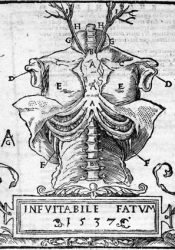Anathomia corporis humani, Mondino de Luzzi
Generally accepted as the first true anatomical dissection manual since Galen’s works in Ancient Greece, Mondino de Luzzi’s Anathomia corporis humani, completed in 1316, became widely distributed after its printing in Padua in 1478. Distinguishing himself from previous scholars who declared the study of anatomy unnecessary, De Lucci opens his work stating that human beings are superior to other animals, and therefore are worthy of study. Anathomia provides detailed sketches and of many major organs, such as the stomach, heart, lungs, and vascular system. It also offers insight into his dissection procedure. While in many cases De Lucci’s interpretations are inaccurate, like his description of the stomach as spherical, his work marked enormous progress in the study of the human form. Anathomia is considered a classic text, and for many centuries used as a reference for many training physicians, including those in the Renaissance.
Sources:
Miranda, Efrain A. “Mondino de Luzzi.” Medical Terminology Dictionary. Clinical Anatomy Associates, 24 Feb., 2014. Web. 15 Feb. 2018. Link
Image courtesy of Wikipedia, page on Mondino de Luzzi, titled Anathomia 1541. Image is public domain

